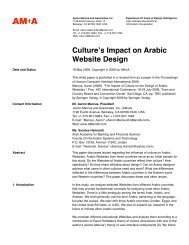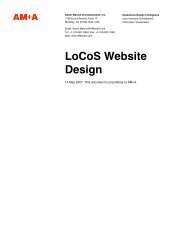Globalization of User-Interface Design for the Web - Aaron Marcus ...
Globalization of User-Interface Design for the Web - Aaron Marcus ...
Globalization of User-Interface Design for the Web - Aaron Marcus ...
You also want an ePaper? Increase the reach of your titles
YUMPU automatically turns print PDFs into web optimized ePapers that Google loves.
iterative. For example, <strong>the</strong> evaluation step described below<br />
may be carried out prior to, during, or after <strong>the</strong> design step:<br />
Plan: Define <strong>the</strong> challenges or opportunities <strong>for</strong><br />
globalization; establish objectives and tactics; determine<br />
budget, schedule, tasks, development-team, and o<strong>the</strong>r<br />
resources. <strong>Globalization</strong> must be specifically accounted <strong>for</strong><br />
in each item or project planning; o<strong>the</strong>rwise, cost-overruns,<br />
delays in schedule, and lack <strong>of</strong> resources are likely to occur.<br />
Research: Investigate dimensions <strong>of</strong> global variables and<br />
techniques <strong>for</strong> all subsequent steps, e.g., techniques <strong>for</strong><br />
analysis, criteria <strong>for</strong> evaluation, media <strong>for</strong> documentation,<br />
etc. In particular, identify items among data and functions<br />
that should be targets <strong>for</strong> change and identify sources <strong>of</strong><br />
national/cultural/local reference. <strong>User</strong>-centered design<br />
<strong>the</strong>ory emphasizes ga<strong>the</strong>ring in<strong>for</strong>mation from a wide variety<br />
<strong>of</strong> users; globalization refines this approach by stressing <strong>the</strong><br />
need to research adequately users’ wants and needs<br />
according to a sufficiently varied spectrum <strong>of</strong> potential users.<br />
In current practice, this variety is <strong>of</strong>ten insufficiently<br />
considered.<br />
Analyze: Examine results <strong>of</strong> research, e.g., challenge or<br />
opportunity (conduct market research), refine criteria <strong>for</strong><br />
success in solving problem or exploiting opportunity (write<br />
marketing or technical requirements), determine key usability<br />
criteria; and define <strong>the</strong> design brief, or primary statement <strong>of</strong><br />
<strong>the</strong> design’s goals. <strong>Globalization</strong> targets should be itemized.<br />
<strong>Design</strong>: Visualize alternative ways to satisfy criteria using<br />
alternative prototypes; based on prior or current evaluations,<br />
select <strong>the</strong> design that best satisfies criteria <strong>for</strong> both general<br />
good UI+IV design as well as globalization requirements;<br />
prepare documents that enable consistent, efficient, precise,<br />
accurate implementation.<br />
Implement: Build <strong>the</strong> design to complete <strong>the</strong> final product or<br />
service, e.g., write code using appropriate tools. In <strong>the</strong>ory,<br />
planning and research steps will have selected appropriate<br />
tools that make implementing global variations efficient.<br />
Evaluate: Review or test results at any stage in <strong>the</strong><br />
marketplace against defined criteria <strong>for</strong> success, e.g.,<br />
conduct focus groups, test usability on specific functions,<br />
ga<strong>the</strong>r sales and user feedback. Identify and evaluate






